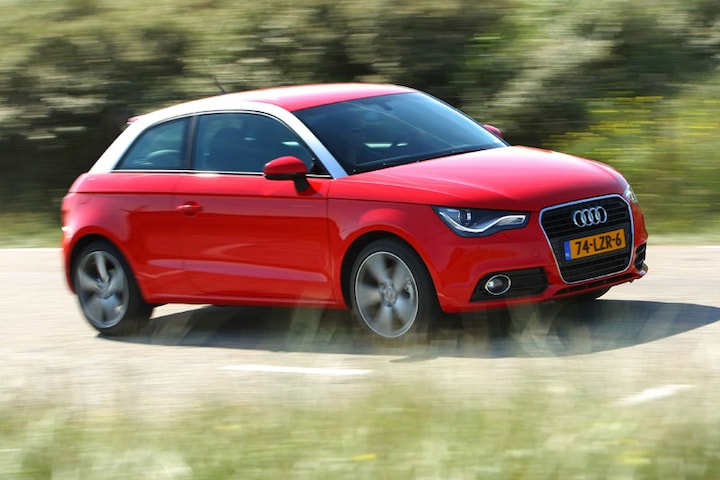At the end of 2007, Audi showed the Metroproject Quattro to the public, a clear harbinger of what would later become the A1. After a long time of warming up – or keeping it wet – the public finally got to know the compact Audi on a Volkswagen basis in 2010. Because although you don’t see it in one or even two glances, a Polo is actually hidden under the A1. The more modal T(F)SI engines are also largely known from this model. That basically makes the Audi A1 a front-wheel drive car. Exceptions to this are the Audi A1 quattro (256 hp) and Audi S1 (231 hp). Although the A1 was announced as a three-door, Audi later unveiled a five-door variant called the Audi A1 Sportback.
How does the Audi A1 drive?
Unlike predecessor A2, the emphasis was therefore not on efficient use of space. Competitor Mini is known as a dynamic driving car, how did Audi give it a twist? “The car steers tight, feels good on the road and can easily keep up with other cars,” writes the owner of an 86 hp Audi A1 1.2 TFSI. “For such a small car, the comfort is better than we thought! The chassis is not too hard, and the 17-inch wheels certainly do not make it less comfortable,” adds another 1.2 TFSI driver.
Others have a different view, although that also has to do with a chosen option. “Something that I already held my breath for was the sports suspension,” writes the driver of an A1 1.0 TFSI from 2015. “This suspension does not benefit comfort, certainly not for the co-drivers in the back. They almost fly through the roof if you drive too fast over a threshold. Even during long journeys you feel every bump in the road surface, which can eventually irritate the co-drivers.”
The owner of an A1 1.2 TFSI Attraction Pro Line Business from 2015 himself makes the comparison with a Mini: “The steering is too distant. I wonder how that is with the facelift version, the controls have been adjusted there. Now you feel too little what you are doing. A Mini, for example, gives much more feedback. I also find the damping very hard, while the suspension is well balanced. Perhaps that is reinforced by the relatively flat 17″ V-spoke wheels with Continental tires?
The stiff chassis is regularly mentioned as a disadvantage, an important plus appears to be the tranquility on board. Engine noises remain in the background and up to 120 km/h the same applies to wind and tire noise. People are also very pleased with the 86 hp 1.2 TFSI. Without exception, owners have the feeling that they have more pulling power and power, only at higher speeds do they notice that this is a fairly modest source of power.
Audi A1 Ruined Interior
The A1 dates back to the time when Audi really made an impression with interior trim. Whether the A1 also benefited from this? And or. “When you get in, you are dealing with an adult car, both in terms of furniture and design, the A1 makes a good impression,” said an owner from the very beginning. “All materials make a high-quality impression, so Audi fully lives up to its premium class even in the smallest version,” he adds. Another compares it to a Volkswagen Golf 7 and comes to the following conclusion: “Both the choice of materials and finish in the Audi A1 are better in many areas. For example, the aluminum climate control knobs, unseen in this class.”
In terms of space, the experiences strongly depend on where you sit in the car. “For the driver and passenger it is very good to stay in the front. There is no lack of legroom and it all feels very spacious,” says the owner of a five-door Audi A1 Sportback. “In the front it is comparable to an Audi A3 or a Mercedes A-Class. The space for the rear passengers is slightly less good for each other. It is very difficult in terms of leg and headroom if you are taller than 1.75. Because at 1.75 meters I just don’t touch the ceiling and I hardly have any legroom left.” In short, in terms of space, the A1 is certainly a Mini risk.
How are the seats?
The Audi A1 is, as befits a German premium car, available with different types of seats. The next owner would have preferred sports seats, but that was not possible in combination with the chosen version. Still, he is ultimately satisfied with the standard ones. “The seats are fine, well adjustable and offer sufficient support. The headrests are also sufficient for taller people, which you sometimes see differently in this segment,” he writes. It’s not such a pleasure for everyone: “If I have to mention a disadvantage, it’s the seats,” writes another. “As soon as I’m in the car for more than 1.5 hours, my lower back hurts because of the limited adjustment options.”
Then the sportier seats, about which a 1.0 TFSI driver is very enthusiastic: “The comfort and design of the sports seats are sublime. The sports seats are equipped with, among other things, two-way adjustable lumbar supports. And thicker side cheeks, which provide extra comfort when cornering.” Yet, according to another, something is missing from these chairs: an extendable seat. “The S-line seats fit like a glove, but I would have liked more support for my lower legs, by means of an extendable part.”
Audi A1: Reliability and irritations
The first generation Audi A1 is a bit older. So we can get a more complete picture of the reliability and real quality. The Audi A1 is not bad in that area, although a striking number of owners report creaks and rattles in the interior. “I’m really not used to Audi, but this car has several creaks that are heard almost continuously, and unfortunately have not yet been resolved,” said a somewhat disappointed Audi driver. “Especially in the morning, during the first half hour, something is clearly rattling under the dashboard.”
In addition, the 1.2 and 1.4 liter TFSI engines are known for timing chain problems. The Audi A1 is also not exempt from these problems, although not every owner reports problems. This owner does, and within 30,000 kilometers: “Meanwhile, the infamous chain was replaced under warranty last year. Heard a rattling sound a few times during a cold start and then you know enough.” The story of this 1.4 TFSI driver proves that not every tap can be traced back to the distribution chain: “The A1 has had a repair once. Suddenly there was a ticking sound when idling, which was heard in the car. Turned out the fuel line was tapping against something. The fuel line was then replaced.” The air conditioning compressor on his car was also replaced at 140,000 kilometers, but a chain problem was not an issue.
Less lucky was the owner who bought a used A1 1.4 TFSI with 147,000 kilometers on the clock. Before the A1 was completely satisfactory, the distribution chain, turbo and clutch were replaced, but the car has now covered more than 200,000 kilometers.
With the A1, Audi took a different tack: it is a small car with, it turns out, big features. At least as long as you’re in the front. Not only the design is pronounced according to Audi standards, also the driving – and in particular the sturdy chassis – appears to be sensitive to taste. Although the design and interior of the car are appreciated, users also report minor irritations in the form of rattles and creaks. Larger technical points of interest relate in particular to the 1.2 and 1.4 TFSI engines. If you are considering a used Audi A1, check carefully whether the problem with this engine has been resolved and also be sure to read the AutoWeek Purchase Advice for the Audi A1.
2023-07-23 13:19:15
#Practical #experience #Audi #owners #Mini #competitor


